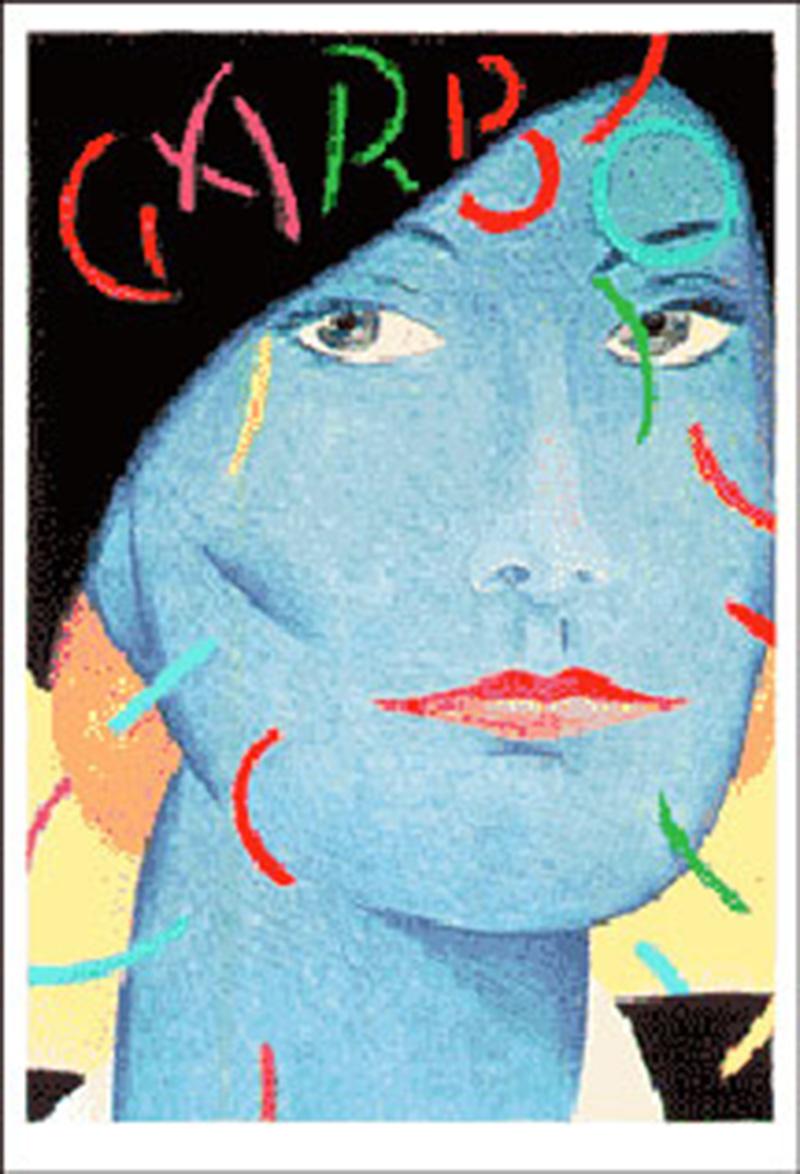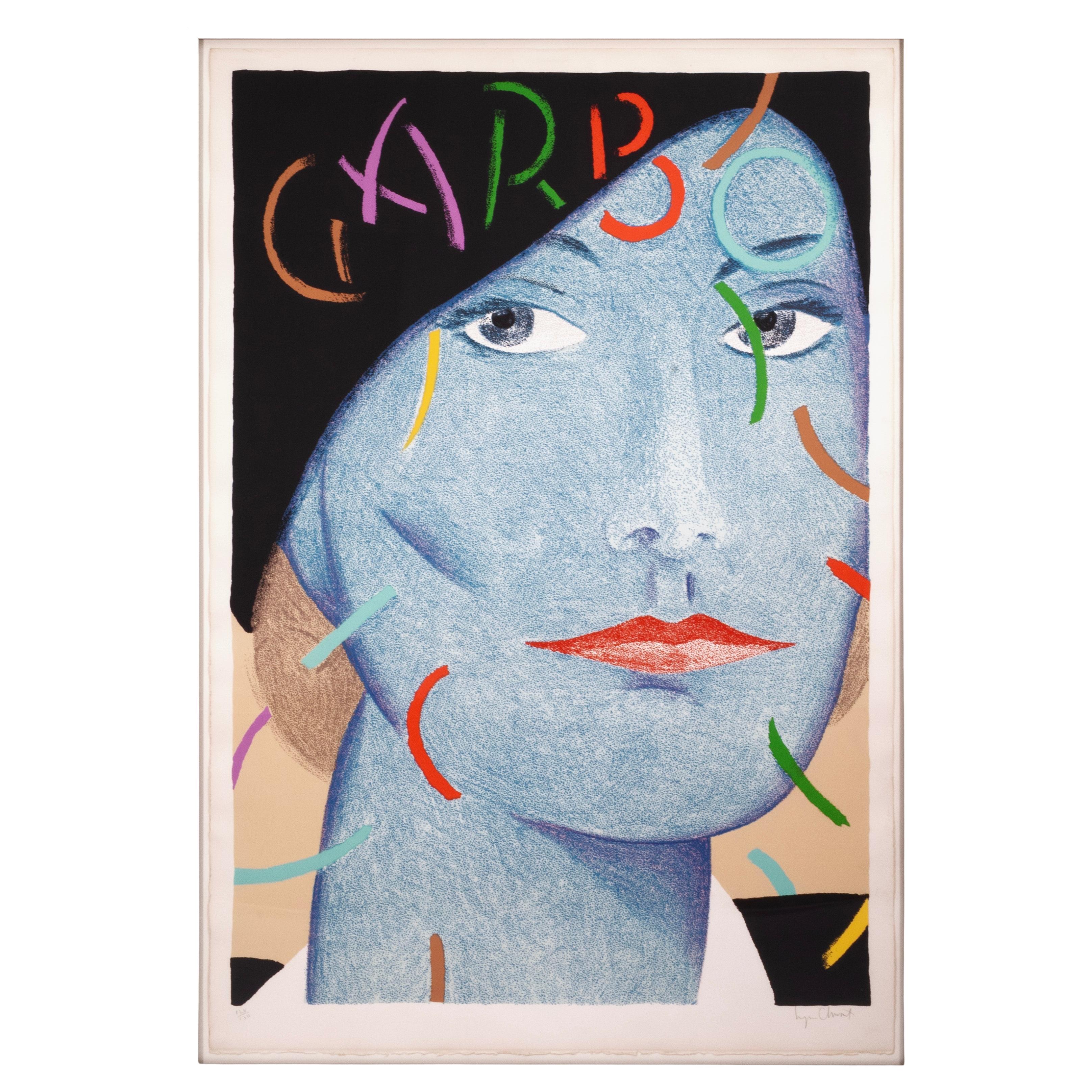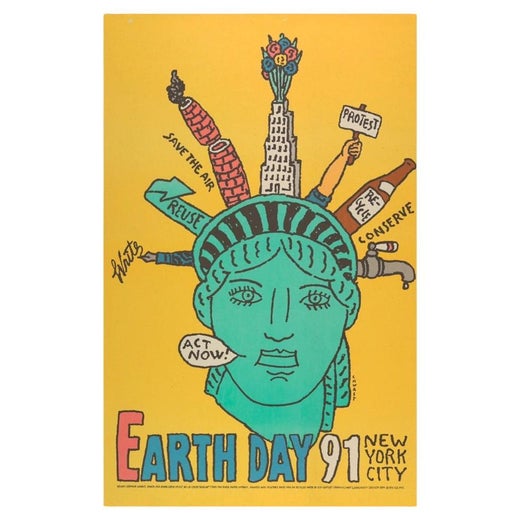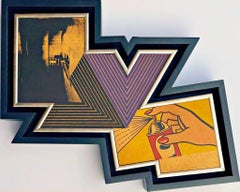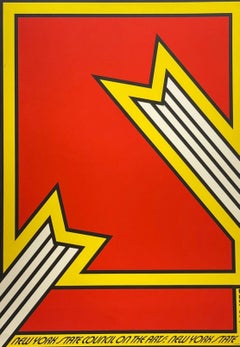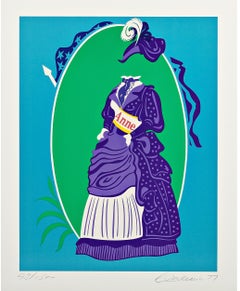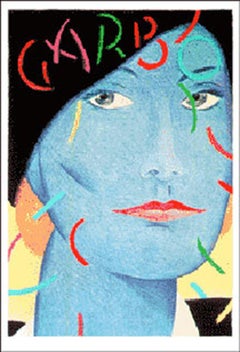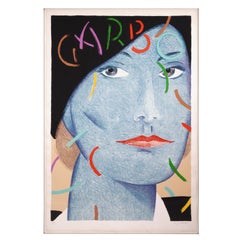Items Similar to Greta Garbo
Want more images or videos?
Request additional images or videos from the seller
1 of 6
Seymour ChwastGreta Garbo1989
1989
$700
£533.28
€608.60
CA$983.67
A$1,072.02
CHF 567.68
MX$12,876.12
NOK 7,186.98
SEK 6,607.72
DKK 4,545.59
About the Item
Seymour Chwast
Greta Garbo, 1989
Silkscreen on Rives BFK
Hand-signed and numbered 36/200 by artist on the front
44 x 30 inches
Unframed
This large, dazzling multi color silkscreen is a close-up portrait of the legendary Hollywood screen siren Greta Garbo with blue skin and wearing a black hat. Confetti of every color is swirling around her face and a few pieces have fallen to resemble the actress's name, Garbo. This print is signed and numbered in pencil by the artist.
A bright, strong impression. There is some mild foxing under the signature (see photo), and at the white margins, much of which will frame out.
About Seymour Chwast:
Seymour Chwast has profoundly affected American graphic design and illustration, both through his stewardship of the seminal Push Pin Studios (which he founded in 1954 with Milton Glaser and Ed Sorel) and his consistent contributions in editorial illustration for periodicals such as The New York Times, Forbes, and Frankfurter Allgemeine. He is the author of more than thirty children's books, and his illustrations can be found on countless posters, packaging, album and book covers, advertisements, and corporate and environmental graphics. When it first gained recognition, Push Pin represented a radical departure from the modernist orthodoxy prevalent in the New York design world, and embraced a flowing and vibrant visual style that would make its mark on the Pop movement of the 1960s; this was recognized in The Push Pin Style, the unprecedented exhibition of American design at the Louvre’s Musée des Arts Decoratifs in 1970. In 1985, the studio’s name was changed to The Pushpin Group, of which Chwast is the director. He is a member of the Art Directors Hall of Fame and a recipient of the AIGA medal. The Seymour Chwast Collection contains 60 original artworks, 79 posters, 33 periodicals (including the Push Pin Graphic and The Nose), many print items, and several hundred slides.
- Creator:Seymour Chwast (1931, American)
- Creation Year:1989
- Dimensions:Height: 44 in (111.76 cm)Width: 30 in (76.2 cm)
- Medium:
- Movement & Style:
- Period:
- Condition:A bright, strong impression. There is some mild foxing under the signature (see photo), and at the white margins, much of which will frame out.
- Gallery Location:New York, NY
- Reference Number:1stDibs: LU1745212716972
Seymour Chwast
Seymour Chwast's posters are in the permanent collections of many museums worldwide. Seymour Chwast"s art helped to propel a revolution in American illustration during the early 1960"s from sentimental realism to comic expressionism. His work for magazines, posters, advertisements, and children"s books influenced at least two generations of illustrators and designers in America and abroad to explore a broad range of stylistic and conceptual methods, as well as to wed illustration with design. In addition to his unique style and innovative techniques, Chwast contributed a delightfully absurdist sense of wit and humor to twentieth century applied art. Although rooted in the decorative traditions of the nascent years of commercial art—notably Victorian, Art Nouveau, and Art Deco—his work is not a synthesis of the past and present, but an invention of the most original kind.
About the Seller
5.0
Gold Seller
Premium sellers maintaining a 4.3+ rating and 24-hour response times
Established in 2007
1stDibs seller since 2022
471 sales on 1stDibs
Typical response time: 1 hour
- ShippingRetrieving quote...Shipping from: New York, NY
- Return Policy
More From This Seller
View AllRichard Pettibone The Appropriation Warhol, Stella, Lichtenstein, Unique Signed
By Richard Pettibone
Located in New York, NY
Richard Pettibone
The Appropriation Print Andy Warhol, Frank Stella, Roy Lichtenstein, 1970
Silkscreen in colors on masonite board (unique variant on sculpted board)
Hand-signed by artist, Signed and dated on the front (see close up image)
Bespoke frame Included
This example of Pettibone's iconic Appropriation Print is silkscreened on masonite board rather than paper, giving it a different background hue, and enabling it work to be framed so uniquely.
The Appropriation print is one of the most coveted prints Pettibone ever created ; the regular edition is on a full sheet with white background; the present example was silkscreened on board, allowing it to be framed in 3-D. While we do not know how many examples of this graphic work Pettibone created, so far the present work is the only one example we have ever seen on the public market since 1970. (Other editions of The Appropriation Print have been printed on vellum, wove paper and pink and yellow paper.)
This 1970 homage to Andy Warhol, Frank Stella and Roy Lichtenstein exemplifies the type of artistic appropriation he was engaging in early on during the height of the Pop Art movement - long before more contemporary artists like Deborah Kass, Louise Lawler, etc. followed suit.
This silkscreen was in its original 1970 vintage period frame; a bespoke custom hand cut black wood outer frame was subsequently created especially to house the work, giving it a distinctive sculptural aesthetic.
Measurements:
Framed 14.5 inches vertical by 18 inches horizontal by 2 inches
Work
13 inches vertical by 16.5 inches horizontal
Richard Pettibone biography:
Richard Pettibone (American, b.1938) is one of the pioneering artists to use appropriation techniques. Pettibone was born in Los Angeles, and first worked with shadow boxes and assemblages, illustrating his interest in craft, construction, and working in miniature scales. In 1964, he created the first of his appropriated pieces, two tiny painted “replicas” of the iconic Campbell’s soup cans by Andy Warhol (American, 1928–1987). By 1965, he had created several “replicas” of paintings by American artists, such as Warhol, Roy Lichtenstein (1923–1997), Ed Ruscha (b.1937), and others, among them some of the biggest names in Pop Art. Pettibone chose to recreate the work of leading avant-garde artists whose careers were often centered on themes of replication themselves, further lending irony to his work. Pettibone also created both miniature and life-sized sculptural works, including an exact copy of Bicycle Wheel by Marcel Duchamp (French, 1887–1968), and in the 1980s, an entire series of sculptures of varying sizes replicating the most famous works of Constantin Brancusi (Romanian, 1876–1957). In more recent years, Pettibone has created paintings based on the covers of poetry books by Ezra Pound, as well as sculptures drawn from the grid compositions of Piet Mondrian (Dutch, 1872–1944). Pettibone straddles the lines of appropriation, Pop, and Conceptual Art, and has received critical attention for decades for the important questions his work raises about authorship, craftsmanship, and the original in art. His work has been exhibited at the Institute for Contemporary Art in Philadelphia, the Museum of Modern Art in New York, the Museum of Contemporary Art in Miami, and the Laguna Art Museum in Laguna Beach, CA. Pettibone is currently based in New York.
"I wished I had stuck with the idea of just painting the same
painting like the soup can and never painting another painting.
When someone wanted one, you would just do another one.
Does anybody do that now?"
Andy Warhol, 1981
Since the mid-1960s, Richard Pettibone has been making
hand-painted, small-scale copies of works by other artists — a
practice due to which he is best known as a precursor of appropriation art — and for a decade now, he has been revisiting subjects from across his career. In his latest exhibitions at
Castelli Gallery, Pettibone has been showing more of the “same”
paintings that had already been part of his 2005–6 museum retrospective,1
and also including “new” subject matter drawn from
his usual roster of European modernists and American postwar
artists. Art critic Kim Levin laid out some phases of the intricate spectrum from copies to repetitions in her review of the
Warhol-de Chirico showdown, a joint exhibition at the heyday
of appropriation art in the mid-1980s when Warhol’s appropriations of de Chirico’s work effectively revaluated “the grand
old auto-appropriator”.
Upon having counted well over a dozen
Disquieting Muses by de Chirico, Levin speculated: “Maybe he
kept doing them because no one got the point. Maybe he needed the money. Maybe he meant it when he said his technique
had improved, and traditional skills were what mattered.”
On
the other side, Warhol, in her eyes, was the “latter-day exemplar
of museless creativity”.
To Pettibone, traditional skills certainly
still matter, as he practices his contemporary version of museless creativity. He paints the same painting again and again,
no matter whether anybody shows an interest in it or not. His
work, of course, takes place well outside the historical framework of what Levin aptly referred to as the “modern/postmodern wrestling match”,
but neither was this exactly his match
to begin with.
Pettibone is one of appropriation art’s trailblazers, but his diverse
selection of sources removes from his work the critique of the
modernist myth of originality most commonly associated with
appropriation art in a narrow sense, as we see, for example, in
Sherrie Levine’s practice of re-photographing the work of Walker
Evans and Edward Weston. In particular, during his photorealist
phase of the 1970s, Pettibone’s sources ranged widely across
several art-historical periods. His appropriations of the 1980s
and 1990s spanned from Picasso etchings and Brancusi sculptures to Shaker furniture and even included Ezra Pound’s poetry.
Pettibone has professed outright admiration for his source artists, whose work he shrinks and tweaks to comic effect but, nevertheless, always treats with reverence and care. His response
to these artists is primarily on an aesthetic level, owing much
to the fact that his process relies on photographs. By the same
token, the aesthetic that attracts him is a graphic one that lends
itself to reproduction. Painstakingly copying other artists’ work by hand has been a way of making
it his own, yet each source is acknowledged in
his titles and, occasionally, in captions on white
margins that he leaves around the image as an
indication that the actual source is a photographic image. The enjoyment he receives in copying
is part of the motivation behind doing it, as is
the pleasure he receives from actually being with
the finished painting — a considerable private
dimension of his work. His copies are “handmade
readymades” that he meticulously paints in great quantities in his studio upstate in New York; the commitment
to manual labor and the time spent at material production has
become an increasingly important dimension of his recent work.
Pettibone operates at some remove from the contemporary art
scene, not only by staying put geographically, but also by refusing to recoup the simulated lack of originality through the
creation of a public persona.
In so doing, Pettibone takes a real
risk. He places himself in opposition to conceptualism, and he is
apprehensive of an understanding of art as the mere illustration
of an idea. His reading of Marcel Duchamp’s works as beautiful
is revealing about Pettibone’s priorities in this respect.
When
Pettibone, for aesthetic pleasure, paints Duchamp’s Poster for
the Third French Chess...
Category
1970s Pop Art Abstract Prints
Materials
Masonite, Pencil, Screen
Lauren Bacall Lights Humphrey Bogart's Cigarette iconic 1966 Pop Art silkscreen
By Bob Stanley
Located in New York, NY
Bob Stanley
Lauren Bacall Lights Humphrey Bogart's Cigarette, 1966
Color Silkscreen on paper with full margins (S/N)
22 1/2 × 17 inches
Hand signed and dated on the lower right front...
Category
1960s Pop Art Figurative Prints
Materials
Screen
Vintage 1970 New York State Council on the Arts Award poster Nicholas Krushenick
By Nicholas Krushenick
Located in New York, NY
Nicholas Krushenick
New York State Council on the Arts Award poster, 1970
Silkscreen on wove paper - original 1970 poster, not a reprint
Unsigned, unnumbered, unframed
35 × 25 inches...
Category
1970s Pop Art Abstract Prints
Materials
Screen, Offset
Anne, inspired by Gertrude Stein's opera about Susan B. Anthony Signed/N print
By Robert Indiana
Located in New York, NY
Robert Indiana
Anne inspired by Susan B. Anthony, 1977
Color Lithograph on Arches Paper
Hand Signed, dated and numbered 93 from the limited edition of 150 (93/150) front in graphite pencil
17 4/5 × 14 inches
Unframed
Robert Indiana, celebrated for his iconic “LOVE” design, entered the realm of the theater in 1966 when he served as a set and costume designer for The Mother of Us All, an adaptation of Gertrude Stein and Virgil Thomson’s 1947 opera about activist Susan B. Anthony during the Women’s Suffrage Movement. Billed as “An American Pop Opera,” the play was first performed at the Guthrie Theatre...
Category
1970s Pop Art Figurative Prints
Materials
Lithograph
Mary Bauermeister at Galleria Schwarz Milano (Hand signed, dated and inscribed)
By Mary Bauermeister
Located in New York, NY
Mary Bauermeister
Mary Bauermeister at Galleria Schwarz Milano (Hand signed, dated and inscribed), 1972
Offset lithograph on exhibition catalogue (hand signed, dated and inscribed in...
Category
1970s Abstract Portrait Prints
Materials
Lithograph, Offset
Richard Phillips, Miss Parkett for Parkett 71, 5 color Pop lithograph, signed/N
By Richard Phillips
Located in New York, NY
Richard Phillips
Miss Parkett for Parkett 71, 2004
5 Color Lithograph on Somerset White paper
Hand signed, numbered 37/70 and dated on lower front
25 4/5 × 20 inches
Unframed
This 5-...
Category
Early 2000s Contemporary Portrait Prints
Materials
Lithograph
You May Also Like
Garbo, Pop Art Screenprint by Seymour Chwast
By Seymour Chwast
Located in Long Island City, NY
A close-up portrait of Greta Garbo with blue skin and wearing a black hat. Confetti of every color is swirling around her face and a few pieces have fallen to resemble the actress's ...
Category
1990s Pop Art Portrait Prints
Materials
Screen
Greta Garbo, Pop Art Portrait Screenprint by Rupert Jasen Smith
By Rupert Jasen Smith
Located in Long Island City, NY
Artist: Rupert Jasen Smith, American (1953 - 1989)
Title: Greta Garbo
Year: 1988
Medium: Screenprint, signed and numbered in pencil
Edition: AP 12/15
Size: 43 x 34 in. (109.22 x 86.3...
Category
1980s Pop Art Portrait Prints
Materials
Screen
Seymour Chwast - Greta Garbo, 1989 Signed Postmodern Silkscreen on Paper 128/150
By Seymour Chwast
Located in Keego Harbor, MI
A postmodern silkscreen on Rives BFK paper titled "Greta Garbo" by Seymour Chwast. Hand signed in pencil on the lower right with an annotation of 128/150 on the lower right. Publishe...
Category
Late 20th Century American Post-Modern Prints
Materials
Paper
Greta Garbo, Pop Art Portrait by Rupert Jasen Smith
By Rupert Jasen Smith
Located in Long Island City, NY
Artist: Rupert Jasen Smith, American (1953 - 1989)
Title: Greta Garbo
Year: 1988
Medium: Screenprint, signed and numbered in pencil
Edition: AP 12/15
Size: 43 x 34 in. (109.22 x 86.3...
Category
1980s Pop Art Portrait Prints
Materials
Screen
$6,000 Sale Price
20% Off
Greta Garbo, Pop Art Screenprint Portrait by Rupert Jasen Smith
By Rupert Jasen Smith
Located in Long Island City, NY
Artist: Rupert Jasen Smith, American (1953 - 1989)
Title: Greta Garbo
Year: 1988
Medium: Screenprint, signed and numbered in pencil
Edition: AP 12/15
Size: 43 x 34 in. (109.22 x 86.3...
Category
1980s Pop Art Portrait Prints
Materials
Screen
Greta Garbo, Pop Art Screenprint Portrait by Rupert Jasen Smith
By Rupert Jasen Smith
Located in Long Island City, NY
Rupert Jasen Smith’s well-known study of Greta Garbo, this portrait is a stunning screenprint. From the set of 6 screenprints from 1988. Smith was Andy Warhol’s favorite printer and ...
Category
1980s Pop Art Portrait Prints
Materials
Screen
More Ways To Browse
Siren Vintage
Leroy Neiman Etchings
Longo Gretchen
Matisse Pasiphae
Picasso Francoise
Picasso Gouache
Picasso Portrait Imaginaire
Rauschenberg Plate
Robert Longo Gretchen
Tete De Jeune Fille
Warhol Invitation
Alex Katz Laura
Alex Katz Orange Hat
Andy Warhol Reigning Queens
Andy Warhol Trial Proof
Basquiat Skull
Castelli Invitation
Chris Levine Lightness Of Being
